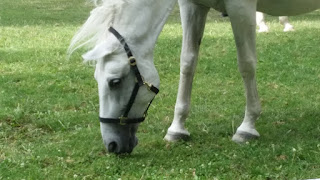 |
| Lipizzan Mares and Foals |
Hi Everyone!
Of the many things that I’ve
seen in Austria, one of my favorites has been the horses in the park. In July,
at the Burggarten, the Lipizzaner mares and foals are normally on display. The
first year, I wasn’t here and I missed the second one. Last year I was so lucky
to be here when they came. This year, I am waiting in anticipation for the
announced dates.
There were tons of people
waiting to see this very special event. It is considered a tradition here and
brings the beautiful horses a little closer to their loving public.
 |
| Mare and Foal |
Here’s are ten facts about this
special breed of horse:
ð There are two common terms used for the horses, either Lipizzans or
Lipizzaners.
ð Most Lipizzans measure 14.2 to
15.2 hands high with the original carriage horses approaching 16.1 hands.
ð Lipizzan horse mature very
slowly therefore allowing them to live and be active longer.
ð Most Lipizzans are gray with
the occasional rare solid colored horse being born.
ð When they are born they are
very dark in coloring, usually bay or black, and become lighter each year until
the process is complete sometime between 6 and 10 years. Yet they are not a
true white horse as they skin is pigmented black as are their eyes.
ð While most are gray to white,
there is a tradition that one bay stallion is always in residence at the
Spanish Riding School of Vienna.
ð They have been a breed since
approximately 800 AD with their predecessors brought to Spain by the Moors.
ð The Habsburgs wanted a powerful
but agile horse for both military and at their riding school. IN 1580 Archduke
Charles II established a stud Lipizza, located today in modern Slovenia, which
consisted of Spanish, Barb and Arabian stock crossed with the now extinct
Neapolitan breed to produce Lipizzaner horses.
ð Every horse that one sees in
the classic Lipizzaner displays is a stallion. They are each chosen
specifically for their ability to get along with other stallions and some are
quite attentive to each other.
ð The most difficult display they
do is known as classic dressage and commonly called airs above the ground.
They have a varied history
during wartime that include many relocations to ensure the breed was safe from
extinction. During WWII, the German high command transferred most of the stock
to Czechoslovakia. This included all the breeding stock from Piber in 1942. The
Spanish Riding School stock was moved to St. Martins, Austria when it was
feared the horses were in danger from the bombing raids on Vienna. In the
spring of 1945, the horses were threatened by the advancing Soviet Army who
might have used the horses for meat.
 |
| Mare at Burggarten |
The head of the Spanish
Riding School at the time, Colonel Alois Podhajsky put on a display for General
George Patton, who was a horse man, and requested his protection. The site where the horse were located had been
occupied in late April by allied forces. The operation became known as ‘Operation
Cowboy’ and resulted in the recovery of 375 Lipizzans.
The stallions were returned to the Spanish
Riding School in 1955 once the Russian occupation was over. In 2015, to
commemorate their rescue, the Lipizzaners celebrated the 60th
anniversary of Patton’s rescue by touring the US.
The stallions come to the
Riding School when they are just four years old and it takes an average of six
years for each horse to be trained. Schooling is only considered complete when
they have mastered the skills required to perform what is known as the “School
Quadrille.” The three skill sets taught to the stallions are forward riding,
campaign school and high-school dressage and this is where the horse maybe
taught ‘Airs Above the Ground.’ It all depends upon the horse how high their
training sights are set for that particular animal.
 |
| Dappled Lipizzaner Foal |
The pictures are
self-explanatory. For a more elaborate look at the Lipizzaners here are a few
websites:
Hope you enjoyed this little
look into Austria and beyond. See you all next week!
Lynn

No comments:
Post a Comment